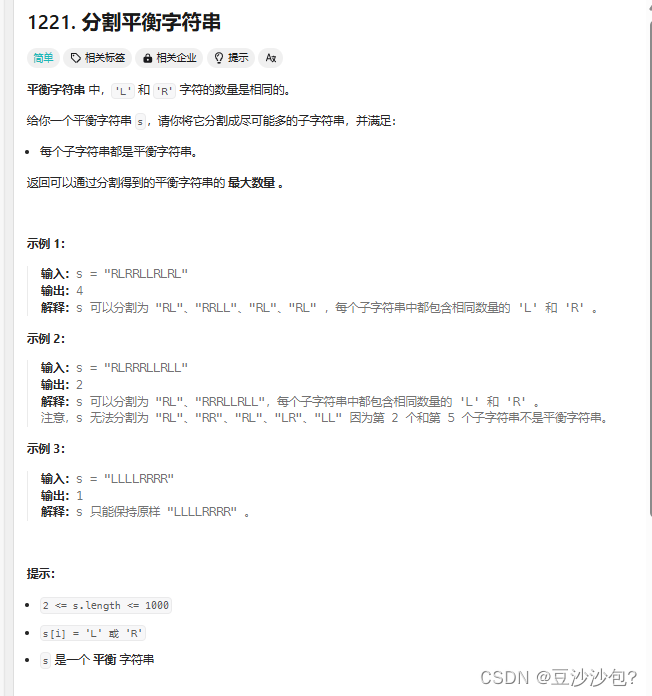1.题目描述

2.知识点和思路
(1)贪心算法的基本思想
选择性质:在每一步中,选择当前最优的选项,不考虑未来的后果。
局部最优解:通过一系列局部最优选择,构建全局最优解。
不可回溯:一旦做出选择,不能回溯来改变之前的选择。
(2)贪心算法的例子
例子 1:找零问题
问题:给定一个金额,求用最少数量的硬币凑出该金额。假设硬币的面值有 1 元、5 元、10 元和 25 元。
贪心算法的思想:每次选择面值最大的硬币。
算法步骤:
选择当前金额下可用的最大面值的硬币。
从总金额中减去该硬币的面值。
重复上述步骤,直到总金额为 0。
import java.util.ArrayList;
import java.util.List;
public class CoinChange {
public static List<Integer> coinChange(int amount) {
int[] coins = {25, 10, 5, 1};
List<Integer> result = new ArrayList<>();
for (int coin : coins) {
while (amount >= coin) {
amount -= coin;
result.add(coin);
}
}
return result;
}
public static void main(String[] args) {
int amount = 41;
List<Integer> result = coinChange(amount);
System.out.println(result); // 预期输出: [25, 10, 5, 1]
}
}
(3)贪心算法的例子2(太抽象了,暂时理解不了)
例子 2:活动选择问题
问题:给定一组活动,每个活动有开始时间和结束时间,要求选择尽可能多的互不重叠的活动。
贪心算法的思想:每次选择结束时间最早的活动,这样可以确保剩下的时间最大化。
算法步骤:
按活动结束时间排序。
选择第一个活动。
对于每个后续活动,如果其开始时间大于等于上一个选择活动的结束时间,则选择该活动。
import java.util.ArrayList;
import java.util.Arrays;
import java.util.List;
public class ActivitySelection {
public static List<int[]> activitySelection(int[][] activities) {
// 按活动结束时间排序
Arrays.sort(activities, (a, b) -> a[1] - b[1]);
List<int[]> result = new ArrayList<>();
int[] lastActivity = activities[0];
result.add(lastActivity);
for (int i = 1; i < activities.length; i++) {
if (activities[i][0] >= lastActivity[1]) {
lastActivity = activities[i];
result.add(lastActivity);
}
}
return result;
}
public static void main(String[] args) {
int[][] activities = {
{1, 4},
{3, 5},
{0, 6},
{5, 7},
{3, 8},
{5, 9},
{6, 10},
{8, 11},
{8, 12},
{2, 13},
{12, 14}
};
List<int[]> result = activitySelection(activities);
for (int[] activity : result) {
System.out.println(Arrays.toString(activity));
}
// 预期输出: [[1, 4], [5, 7], [8, 11], [12, 14]]
}
}
(4)返回可以通过分割得到的平衡字符串的 最大数量 。
我的思路是要返回平衡字符串的最大数量,说明分割的子字符串要足够的小,且保证字符串的两种字符的数量是想等的。
(5)字符串分割是处理和解析字符串的常见操作。
例子1:使用 split 方法
split 方法使用正则表达式将字符串分割成子字符串数组。
public class SplitExample {
public static void main(String[] args) {
String str = "apple,banana,cherry";
String[] fruits = str.split(",");
for (String fruit : fruits) {
System.out.println(fruit);
}
// 预期输出:
// apple
// banana
// cherry
}
}
例子2:知道分割的位置,可以使用 substring 方法手动分割字符串。
public class SubstringExample {
public static void main(String[] args) {
String str = "apple-banana-cherry";
int firstDash = str.indexOf("-");
int secondDash = str.indexOf("-", firstDash + 1);
String firstPart = str.substring(0, firstDash);
String secondPart = str.substring(firstDash + 1, secondDash);
String thirdPart = str.substring(secondDash + 1);
System.out.println(firstPart);
System.out.println(secondPart);
System.out.println(thirdPart);
// 预期输出:
// apple
// banana
// cherry
}
}
补充1:substring 方法在 Java 中用于从字符串中提取子字符串。它有两种主要的使用方式:
1)substring(int beginIndex):返回从指定的起始索引(包含)开始到字符串末尾的子字符串。
public class SubstringExample1 {
public static void main(String[] args) {
String str = "apple-banana-cherry";
// 从索引 6 开始到字符串末尾的子字符串
String subStr1 = str.substring(6);
System.out.println(subStr1); // 预期输出: banana-cherry
}
}
2)substring(int beginIndex, int endIndex):返回从指定的起始索引(包含)到结束索引(不包含)之间的子字符串。
public class SubstringExample2 {
public static void main(String[] args) {
String str = "apple-banana-cherry";
// 从索引 6 开始到索引 12 (不包含) 的子字符串
String subStr2 = str.substring(6, 12);
System.out.println(subStr2); // 预期输出: banana
}
}
补充2:str.indexOf(“-”) 方法在 Java 中用于查找字符串中第一次出现指定子字符串或字符的位置。它返回子字符串或字符在字符串中的索引(位置),如果找不到则返回 -1。
public class IndexOfExample {
public static void main(String[] args) {
String str = "apple-banana-cherry";
// 找到第一个 '-' 的位置
int firstDash = str.indexOf("-");
System.out.println("The first '-' is at index: " + firstDash); // 预期输出: 5
// 找到第二个 '-' 的位置,从第一个 '-' 之后开始搜索
int secondDash = str.indexOf("-", firstDash + 1);
System.out.println("The second '-' is at index: " + secondDash); // 预期输出: 12
}
}
补充3:结合 indexOf 和 substring 使用
public class CombinedExample {
public static void main(String[] args) {
String str = "apple-banana-cherry";
// 找到第一个 '-' 的位置
int firstDash = str.indexOf("-");
// 找到第二个 '-' 的位置,从第一个 '-' 之后开始搜索
int secondDash = str.indexOf("-", firstDash + 1);
// 提取第一个 '-' 之前的子字符串
String firstPart = str.substring(0, firstDash);
System.out.println("First part: " + firstPart); // 预期输出: apple
// 提取第一个 '-' 和第二个 '-' 之间的子字符串
String secondPart = str.substring(firstDash + 1, secondDash);
System.out.println("Second part: " + secondPart); // 预期输出: banana
// 提取第二个 '-' 之后的子字符串
String thirdPart = str.substring(secondDash + 1);
System.out.println("Third part: " + thirdPart); // 预期输出: cherry
}
}
补充4:实现括号平衡检查
import java.util.Stack;
public class BalancedParentheses {
public static boolean isBalanced(String s) {
Stack<Character> stack = new Stack<>();
for (char c : s.toCharArray()) {
if (c == '(' || c == '{' || c == '[') {
stack.push(c);
} else if (c == ')' || c == '}' || c == ']') {
if (stack.isEmpty()) {
return false;
}
char top = stack.pop();
if (!isMatchingPair(top, c)) {
return false;
}
}
}
return stack.isEmpty();
}
private static boolean isMatchingPair(char left, char right) {
return (left == '(' && right == ')') ||
(left == '{' && right == '}') ||
(left == '[' && right == ']');
}
public static void main(String[] args) {
String test1 = "{[()]}";
String test2 = "{[(])}";
String test3 = "{{[[(())]]}}";
System.out.println(isBalanced(test1)); // 预期输出: true
System.out.println(isBalanced(test2)); // 预期输出: false
System.out.println(isBalanced(test3)); // 预期输出: true
}
}
3.代码实现
先弄L,R计数器,还有一个平衡计数器。
在for循环里面(首先要满足将字符串变成字符数组,也就是s.toCharArrat())
对L、R字符进行计数,当cntL==cntR的时候,平衡字符串计数+1,cntL和cntR重新置0.
class Solution {
public int balancedStringSplit(String s) {
int cntL=0;
int cntR=0;
int BalanceCnt=0;
for(char c:s.toCharArray())
{
if(c=='R')
{
cntR++;
}
else if(c=='L')
{
cntL++;
}
if(cntR==cntL)
{
BalanceCnt++;
cntR=0;
cntL=0;
}
}
return BalanceCnt;
}
}





















 559
559

 被折叠的 条评论
为什么被折叠?
被折叠的 条评论
为什么被折叠?








